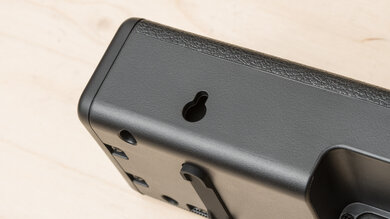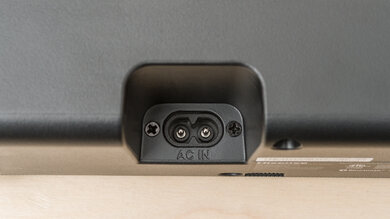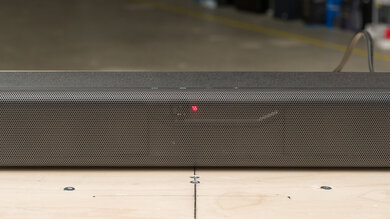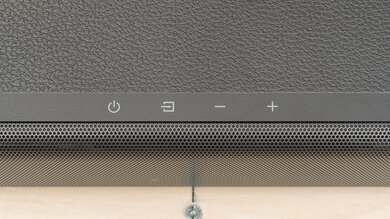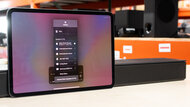The Hisense HS214 is a budget-friendly standalone soundbar with an integrated subwoofer to improve its bass performance. Thanks to its small and compact design, it's easy to fit into your existing setup. Of course, like most models in its price range, it's pretty limited regarding sound enhancement features and support for various audio formats commonly found on streaming services and Blu-rays. Still, it's Bluetooth compatible, and the manufacturer also advertises it as Roku TV Ready, which is handy if you want easy setup with a compatible TV.
Our Verdict
The Hisense HS214 soundbar is sub-par for mixed usage. This small, budget-friendly soundbar makes for an affordable upgrade over your existing TV speakers, but that's about it. Dialogue in movies and TV shows is clearly reproduced, and there are a couple of EQ presets to enhance its sound. However, it lacks a lot of low bass, even with its integrated subwoofer. You won't find many sound customization tools, and there isn't support for a lot of popular audio formats like Dolby Atmos.
-
Some EQ presets.
-
Gets loud.
-
Lacks low bass.
-
Minimal sound enhancement features.
-
Downmixes surround sound into stereo.
The Hisense HS214 is acceptable for dialogue-centric content like TV shows and podcasts. It's a 2.1 setup, meaning it lacks a dedicated center channel to improve vocal reproduction. Still, it can use its left and right channels to simulate a sound in the center, and voices are clear and easy to follow overall. You can even use its News preset to enhance dialogue in the mix. That said, it doesn't have many customization tools aside from that.
-
Some EQ presets.
-
Minimal sound enhancement features.
The Hisense HS214 soundbar isn't bad for music. This soundbar lacks a lot of thump and rumble in the low bass, but this is typical for a standalone bar. It still reproduces voices and lead instruments with clarity and accuracy, and its bass adjustment tool helps bring more warmth in the mid-to-high bass range. Plus, it gets loud enough for an average-sized living room. That said, aside from bass adjustment, you won't find many other sound enhancement features to customize its performance.
-
Bass adjustment tool.
-
Some EQ presets.
-
Lacks low bass.
-
Minimal sound enhancement features.
The Hisense HS214 soundbar is a poor choice for watching movies. It's a small soundbar, and while it gets loud, it struggles to bring out the deep and rumbling low bass with action-packed scenes. Surround sound formats like Dolby Digital are downmixed into stereo, which brings a less life-like feel to the sound. You won't find support for more advanced formats like Dolby Atmos, either. While the bar comes with a virtual surround mode to enhance its immersive feel, unfortunately, in practice, this tool brings out strange sound artifacts that take away from the overall listening experience.
-
Gets loud.
-
Lacks low bass.
-
Downmixes surround sound into stereo.
- 5.7 Mixed Usage
- 6.0 Dialogue/TV Shows
- 6.1 Music
- 5.2 Movies
Changelog
- Updated Mar 21, 2024: We've added a comparison between this soundbar and the Hisense HS2100 in Stereo Frequency Response.
- Updated Feb 19, 2024: Review published.
- Updated Feb 15, 2024: Early access published.
- Updated Jan 30, 2024: Our testers have started testing this product.
- Updated Jan 26, 2024: The product has arrived in our lab, and our testers will start evaluating it soon.
Check Price
Differences Between Sizes And Variants
The Hisense HS214 is available in Black, and you can see the label for the model we tested here.
If you come across another version of this soundbar, please let us know in the forums.
Popular Soundbars Comparisons
The Hisense HS214 is a small standalone soundbar available at an affordable price. It's well-built in comparison with other budget models, though it still lacks higher-end sound enhancement tools and features to make the most of its sound. As with most models with integrated subwoofers, it lacks a lot of low bass. You may find it's worth the value if you want a simple upgrade over your TV speakers, but more avid audiophiles will want to check out more premium options.
See also our recommendations for the best small soundbars, the best soundbars under $100, and the best budget soundbars.
The Hisense HS214 and the Hisense HS2100 are both budget soundbars. While the HS2100 has a 2.1 configuration, the HS214 is a standalone bar with no dedicated subwoofer. As a result, it lacks low bass compared to its 2.1 sibling. It also lacks sound enhancement features, with three default EQ presets and a virtual surround sound feature that subjectively makes vocals and dialogue less clear. It also lacks Dolby Digital and DTS support, which are both present in the HS2100. That said, the HS214 has a better build quality and a more compact design that will fit under smaller TV setups.
The Sony HT-S100F and the Hisense HS214 are both budget-friendly standalone soundbars, and the Sony is the best of the two. The Sony is a little wider than the Hisense, but if you have the space, it's worth it since it has more sound enhancement features and a louder sound. That said, it's not quite as well-built as the Hisense.
The Roku Streambar is more expensive than the Hisense HS214, but it's worth it if you want a bar with more sound enhancement features. Unlike the Hisense, it has an auto-volume mode and treble adjustment. Plus, it supports more wireless playback options and has a better stereo soundstage. It's smaller than the Hisense, though it doesn't get quite as loud as its competitor.
The TCL Alto 6 is the better budget bar compared to the Hisense HS214. The TCL is a little bigger, and it can get a bit louder. Plus, it has a better stereo soundstage. It's not as well-built as the Hisense, and it lacks a bass adjustment feature.
The Creative Stage and the Hisense HS214 are both budget-friendly soundbars with different strengths. The Creative Stage is more designed for use with computers, and it comes with a subwoofer, so it can bring more thump and rumble in the bass range. This soundbar can only playback 2.0 PCM content, which is quite limiting, especially since the Hisense supports Dolby Digital.
Test Results
The Hisense HS214 is a small standalone soundbar with a similar design to other budget models like the Sony HT-S200F. It has a rectangular shape with openings on each side, one of which is for the bass port.
This bar has a good build quality, which is impressive for the price. It's mostly made of plastic, and the plastic on top of the bar is made to look and feel like leather, at least from afar. Up close, though, it has a cheaper look. The metal grille in front of the bar helps to protect the drivers inside. Plus, there are rubber feet on the bottom to hold the bar in place. There isn't a grille covering the integrated subwoofer, but it's not much of an issue since it's located at the bottom of the bar.
The Hisense HS214 has a middling stereo frequency response. Like most standalone bars, it really struggles to bring the deep thump and rumble in the low bass. The mid-to-high bass range is also underemphasized, resulting in a lack of warmth in the mix. Still, thanks to its balanced mids, voices and other instruments are reproduced with clarity and accuracy. It's worth looking at this bar's 2.1 sibling, the Hisense HS2100, if you want a similarly-featured soundbar with a dedicated sub for a warmer sound. Subjectively, the Music and Movie EQ presets perform about the same. We tested this soundbar with its virtual surround feature turned off since this subjectively offers a better sound. When it's turned on, voices are veiled, and additional sound artifacts are introduced to the mix, which severely impacts the enjoyability of your listening experience.
If you prefer a more neutral sound with stereo content, set the bass to 4. You notice more warmth and punch in the mid-to-high bass range, especially with more bass-heavy songs. Voices and other instruments remain clearly reproduced.
The Hisense HS214 is a smaller soundbar, and its stereo soundstage is perceived to be only about as wide as the bar itself. You can widen it a bit using the virtual surround mode, but as we mentioned in the boxes above, this comes at the expense of the overall sound quality. Focus is good, though, which is nice, as it's easy to pinpoint sound effects and instruments to accurate locations in the space in front of you.
This soundbar gets loud enough to fill most living rooms with sound. Compression falls within good limits, too, even when you push it to max volume.
Since the Hisense HS214 is a 2.1 soundbar, it lacks a discrete center channel to improve vocal reproduction. Instead, it uses its left and right stereo channels to create a phantom sound in the center. It reproduces voices clearly, but they're more diffused in the mix as a result.
This is a 2.1 soundbar, meaning it has to downmix surround sound formats like Dolby Digital into stereo to play them back. The resulting sound isn't quite as clear or life-like as what you get with dedicated surround channels. Sound seems like it's coming from a speaker placed in front of you rather than from speakers placed all around you.
You're not going to find a lot of sound enhancement features with soundbars at this price point, and the Hisense HS214 is no exception. You're limited to a few EQ presets, including Movie, Music, and News. News doubles as a dialogue enhancement tool, lowering the bass and raising the mid-treble to make voices clearer in the mix. This soundbar also has a virtual surround mode designed to create a more immersive sound. Subjectively, it doesn't provide a very good listening experience, though. It widens the soundstage a little but at the expense of the overall sound quality. Voices are veiled with it on, and strange sound artifacts are introduced to the mix. We recommend keeping it off for the best possible listening experience.
You can connect this soundbar to your TV over an HDMI or Optical connection. Plus, if you have an older TV with a Coaxial output, you can connect it to the bar's Coaxial input.
Like most budget-friendly bars, there isn't a lot of support for multichannel audio formats. Still, you can playback Dolby Digital content, which is one of the most common surround sound formats on both Blu-rays and streamers.
The bar can playback Dolby Digital content over an Optical connection. Of course, since it's a 2.1 bar, it has to downmix it into stereo to play it back.
Thanks to its lower audio latency, this soundbar is suitable for watching videos and movies over an ARC connection. You aren't likely to notice any lip-synching errors, though it's worth noting that some apps and TVs will compensate for this differently.
Audio latency is decent over an Optical connection. You're more likely to notice a delay between the audio you hear and the visuals on screen when you watch Dolby Digital content. Some apps and TVs compensate for this differently, though.
Without a Full HDMI In port, this soundbar isn't suitable for video passthrough to your TV.
Streaming content wirelessly from your mobile devices is easy, thanks to Bluetooth support.
While this bar doesn't have a display, there's a singular LED on the front to give you information on the bar's status. For example, it changes colors to show which source you're using. It's a bit confusing, though, especially when it comes to using the bass adjustment tool since there's no way to see what level you're on.
Comments
Hisense HS214: Main Discussion
Let us know why you want us to review the product here, or encourage others to vote for this product.
- 21010
Hello, i bought the Hisense HS214, i want to put the setting you recommend, but how do i know when the surround is active or off?, because when i push the bottom on the controller i see that the light flashes differently when i push the bottom again, but i don´t know which flash combination mean on or ff. I have the same problem with the bass, you recommend 4 level of bass, but how do i know which level i am?
Update: We’ve added a comparison between this soundbar and the Hisense HS2100 in Stereo Frequency Response.
- 21010
When will it be finished? I want to know the bass effecet, cause it is a AIO style design, thanks
Our testers have started testing this product; is there anything specific you’re looking to see? Let us know in this thread.





